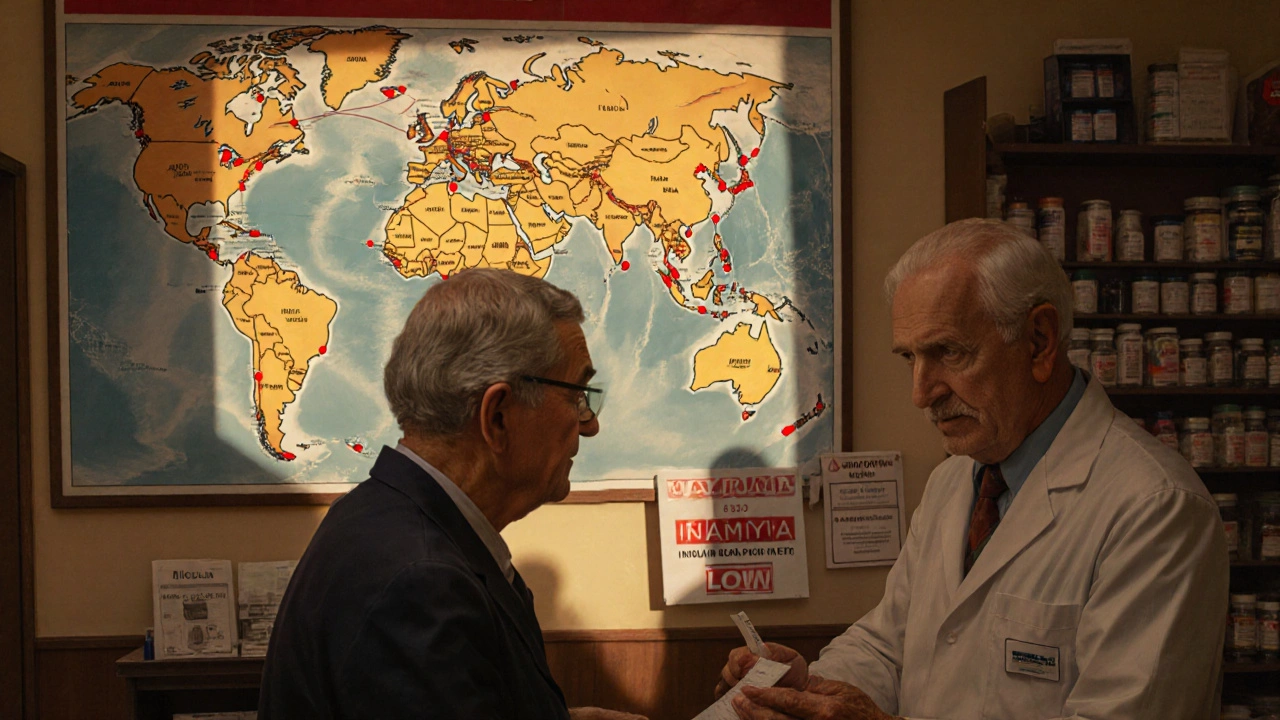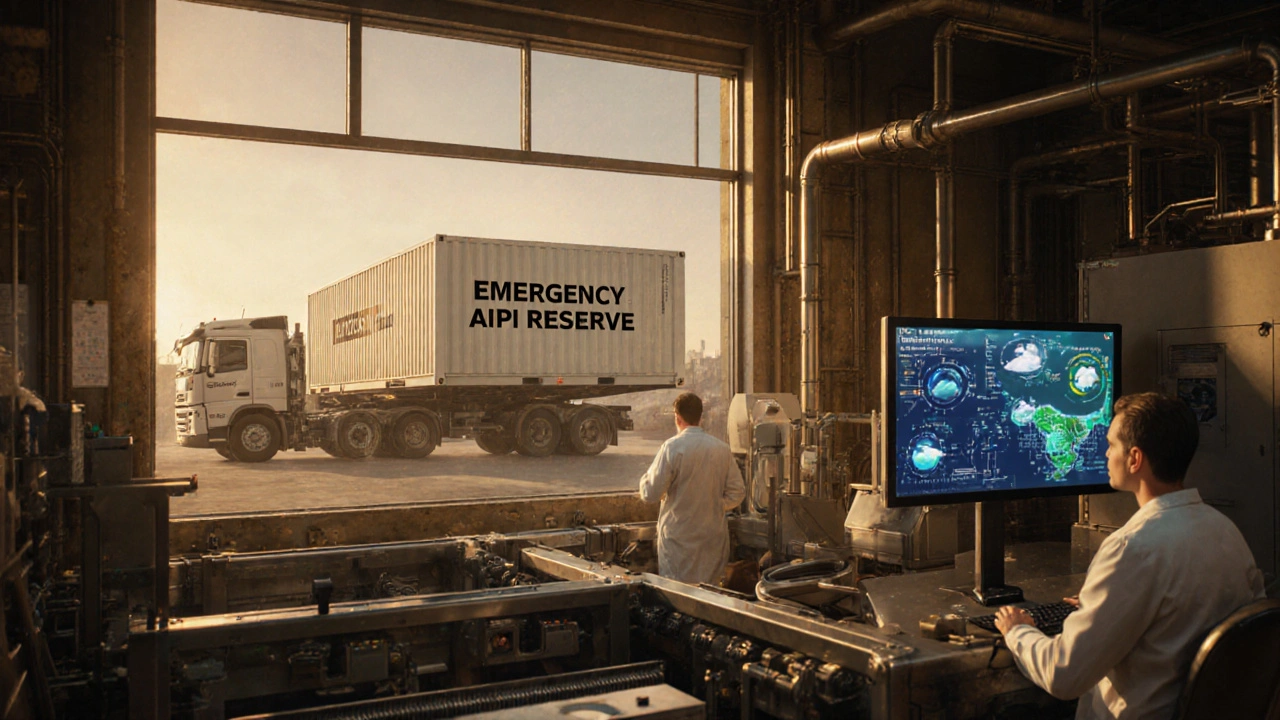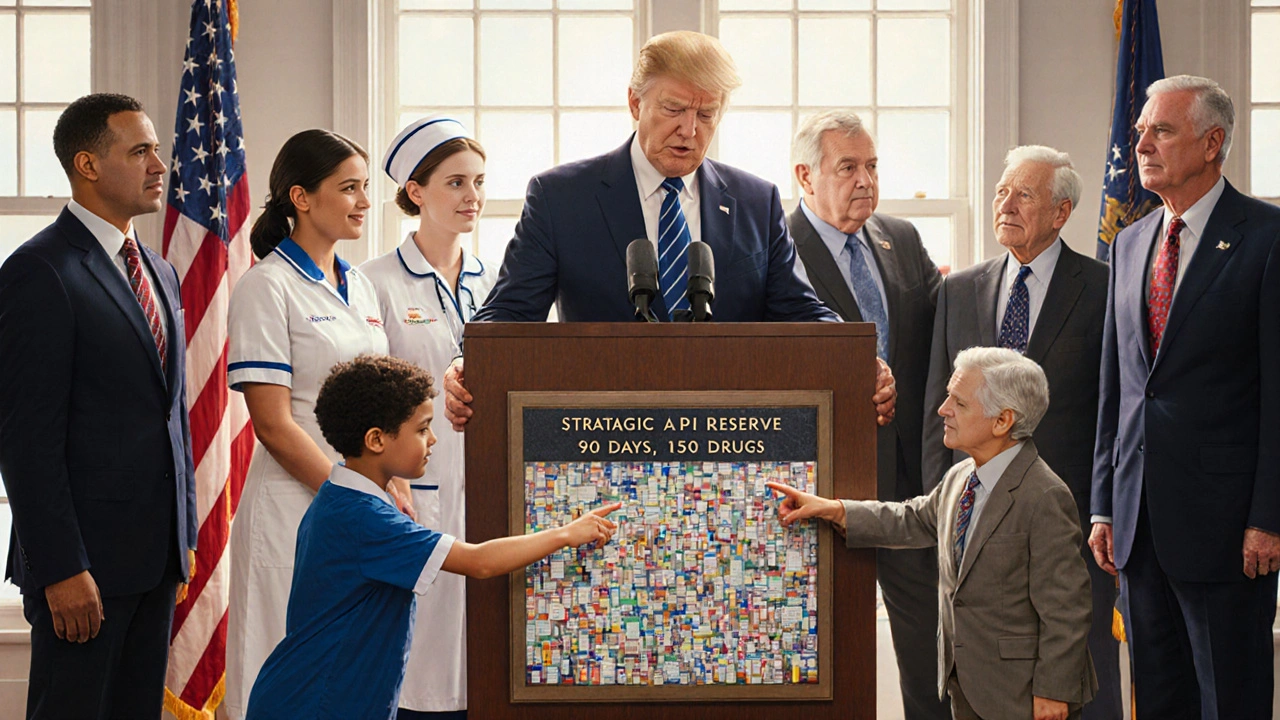Preventive Measures: Building Resilient Pharmaceutical Supply Chains to Stop Drug Shortages
 Nov, 16 2025
Nov, 16 2025
When a life-saving medication disappears from pharmacy shelves, it’s not just an inconvenience-it’s a crisis. In 2024, over 300 prescription drugs faced shortages in the U.S. alone, including antibiotics, cancer treatments, and insulin. Many of these weren’t due to sudden spikes in demand. They were the result of fragile supply chains that broke under pressure. The truth is, we’ve been lucky so far. The next disruption could be worse. Building a pharmaceutical supply chain that can withstand shocks isn’t optional anymore. It’s a matter of public health and national security.
Why Your Medicine Might Vanish Tomorrow
Most people assume their pills come from a local factory. They don’t. About 80% of the active ingredients in U.S. drugs are made overseas, mostly in China and India. Just two countries produce nearly 70% of the world’s active pharmaceutical ingredients (APIs). That’s not diversity-it’s a single point of failure. If a factory in Shanghai shuts down because of a flood, or if trade restrictions hit New Delhi, the ripple effect hits hospitals in Ohio, pharmacies in Florida, and clinics in Brisbane. The problem isn’t just geography. It’s concentration. One facility might supply 60% of the world’s heparin. Another makes 80% of the raw material for certain antibiotics. When that one plant has a quality issue or a power outage, there’s no backup. No spare parts. No quick switch. That’s how a minor hiccup becomes a national shortage. And it’s getting worse. Geopolitical tensions, climate disruptions, and shifting trade policies are making global supply chains more unpredictable. The U.S. government now classifies pharmaceutical supply chain gaps as critical national security risks-not just economic ones. If you can’t get the drugs your soldiers need, or the vaccines your population relies on, you’re vulnerable.What Resilience Really Means
Resilience isn’t about having more inventory. It’s about having options. The Mathematica Inc. report from 2023 defines it clearly: the ability to anticipate, prepare for, respond to, and recover from disruptions while still delivering critical medicines. That’s three things you need: foresight, flexibility, and speed. Leading companies aren’t just stocking up. They’re rebuilding their networks. Instead of relying on one supplier in one country, they’re dual-sourcing-finding a second manufacturer, preferably in a different region. For the most critical drugs, they’re aiming to have two or even three suppliers across three different continents. That way, if one region goes dark, the others can pick up the slack. They’re also building buffer stocks. Not just a few extra weeks’ supply. For essential medicines like epinephrine or morphine, top performers now keep 60 to 90 days of inventory on hand. That’s not waste-it’s insurance. And it’s working. Companies with these strategies saw 23% higher operational continuity during the last major disruption. That translates to millions in avoided losses and, more importantly, lives saved.Technology Is Changing the Game
Old-school batch manufacturing-making medicine in large, slow, one-off runs-is being replaced. Continuous manufacturing is the future. It’s like turning a factory into a流水线 (assembly line) for pills. Instead of waiting weeks to produce a batch, you run it nonstop, day and night. The result? 30-40% smaller facilities, 20-25% less energy use, and 15-20% less waste. But the real power comes from AI. Predictive tools now scan global data-weather patterns, port delays, political unrest, even social media chatter about drug rumors-to forecast disruptions 60 to 90 days in advance. One pilot program cut counterfeit drug incidents by 75% using blockchain to track every pill from raw ingredient to patient. That’s not sci-fi. It’s happening in labs in Boston, Berlin, and Brisbane. And then there’s modular manufacturing. Imagine shipping a factory in a container. These portable units can be set up in 12 to 18 months-instead of the 3 to 5 years it takes to build a traditional plant. They can scale from 50kg to 2,000kg of API production. That means you can produce critical drugs closer to home, faster, and with less risk. The catch? These technologies cost $50 million to $150 million per facility. That’s 3 to 5 times more than a traditional plant. Small companies can’t afford it. That’s why government support and public-private partnerships are critical.
Government Action Is Accelerating
In August 2025, the U.S. government launched the Strategic Active Pharmaceutical Ingredients Reserve. Think of it like the Strategic Petroleum Reserve-but for medicine. The goal? Stockpile 90 days’ worth of 150 essential drugs by 2027. That includes antibiotics, antivirals, and injectables-exactly the ones that keep disappearing. The federal government has also poured $1.2 billion into domestic manufacturing through the CHIPS and Science Act, with another $800 million proposed in 2025. That’s not just about patriotism. It’s about control. Right now, the U.S. makes only 28% of its essential APIs. For sterile injectables? Just 12%. For antibiotics? 17%. Those numbers are dangerous. The FDA is helping too. They’ve cut approval times for continuous manufacturing from 24-36 months down to 12-18 months. That’s huge. It means companies can test new tech faster, scale up quicker, and get better drugs to market sooner. But here’s the catch: tariffs alone won’t fix this. You can’t just slap taxes on Chinese imports and expect American factories to magically fill the gap. We don’t have the workforce, the infrastructure, or the supply chain ecosystem yet. The goal isn’t to bring everything home. It’s to bring the right things home-critical drugs that can’t afford to be interrupted.What Works in Practice
The most successful companies follow a clear four-step process:- Map every supplier-not just Tier 1, but Tier 12. One company found a critical ingredient came from a lab in Romania, supplied by a distributor in Turkey, who sourced the chemical from a plant in China. That’s the kind of hidden risk you need to see.
- Run real-world scenarios-What if India bans exports? What if a hurricane hits a port in Singapore? What if a key supplier gets fined for quality violations? Test your response. Practice it. The companies that do this cut decision time by 40-60% during real crises.
- Invest in data-Silos kill resilience. If procurement, manufacturing, and logistics don’t share the same data, you’re flying blind. Top performers use integrated platforms that reduce vulnerability detection from 45 days to just 7.
- Start small, scale fast-Don’t wait to fix everything. Pick one high-risk drug. Dual-source it. Build a 60-day buffer. Automate its tracking. Prove it works. Then do it again.

The Cost of Doing Nothing
Resilience isn’t cheap. It adds 8-12% to the cost of goods sold. But the alternative is worse. A single major drug shortage can cost a large pharmaceutical company $14.7 million in lost revenue. Hospitals pay more for emergency alternatives. Patients delay treatment. Deaths rise. And the workforce gap? By 2027, the industry will be short 250,000 skilled manufacturing workers. Training programs are lagging. Regulatory standards still don’t match across countries. Only 35% of manufacturing rules are aligned globally. If you think this is someone else’s problem-think again. If you rely on prescription drugs, your life is tied to this system. And if you’re a policymaker, a pharmacist, or a patient advocate, you have a role to play. Push for transparency. Demand buffer stocks. Support local manufacturing where it makes sense. Hold leaders accountable.What Comes Next
By 2030, experts predict 65-70% of U.S. pharmaceutical needs will come from regional networks-not just one country. Domestic production will rise to 35-40%. Continuous manufacturing will power 45-50% of new facilities. And AI will be the silent guardian, predicting disruptions before they happen. But resilience won’t come from one policy, one factory, or one technology. It will come from a mix: smart government action, private investment, global cooperation, and better data. It’s not about being self-sufficient. It’s about being prepared. The next time you pick up your prescription, ask: Is this medicine made in a single, vulnerable spot? Or is it backed by a network that can bend-but not break?What causes pharmaceutical supply chain disruptions?
Disruptions come from many sources: natural disasters like floods or earthquakes affecting factories, geopolitical conflicts that limit exports, trade restrictions, quality control failures at overseas plants, labor strikes, port delays, and even cyberattacks on logistics systems. The biggest risk is over-reliance on one or two countries for active pharmaceutical ingredients (APIs), especially China and India, which together produce 68% of the world’s APIs.
How can drug shortages be prevented?
Preventing shortages requires a mix of strategies: dual-sourcing critical drugs from multiple geographic regions, maintaining 60-90 days of inventory for essential medicines, investing in continuous manufacturing to reduce dependency on large batch production, using AI to predict disruptions before they happen, and building government-backed strategic reserves of key medications. Transparency across the supply chain-from raw materials to final packaging-is also essential.
Is making drugs in the U.S. the solution?
Domestic production helps, but it’s not the whole answer. The U.S. currently makes only 28% of its essential APIs. Building more factories takes years, costs billions, and requires skilled workers we don’t yet have. The goal isn’t to bring everything home-it’s to secure the most critical drugs domestically while diversifying other sources globally. Over-relying on one country, even your own, creates new risks.
What role does AI play in supply chain resilience?
AI helps predict disruptions by analyzing global data-weather, politics, shipping delays, supplier financial health, and even social media trends. Leading systems can forecast risks 60 to 90 days in advance with 85-90% accuracy. AI also improves manufacturing efficiency, reducing quality errors by 25-30% and boosting yields. In one pilot, AI-powered blockchain tracking cut counterfeit drugs by 75%.
How much does it cost to build a resilient supply chain?
Investing in resilience adds 8-12% to the cost of goods sold. A single continuous manufacturing facility can cost $50 million to $150 million-3 to 5 times more than a traditional plant. But the cost of inaction is higher: a single major drug shortage can cost large companies $14.7 million in lost revenue. Companies that invest see a 1.8x return on investment within three years through avoided disruptions and improved market access.
What’s the Strategic Active Pharmaceutical Ingredients Reserve?
Launched in August 2025 by the U.S. government, this reserve is a stockpile of essential medicines designed to cover 90 days of demand for 150 critical drugs-like antibiotics, insulin, and antivirals. It’s modeled after the Strategic Petroleum Reserve and aims to prevent shortages during global crises. The goal is to have it fully stocked by 2027, funded by $2 billion in federal investments.

vinod mali
November 16, 2025 AT 17:39in india we make a lot of apis but the quality control is always a gamble
one factory can be clean next door is a mess
you think you're safe until the batch fails and hospitals panic
we need global standards not just more factories
Joyce Genon
November 18, 2025 AT 15:23oh please lets not pretend this is some heroic rescue mission
the real problem is pharma companies stopped investing in domestic capacity because they could outsource to the cheapest lab with zero oversight
now they want taxpayers to foot the bill for their greed
they made billions off cheap imports and now they're crying wolf when the wolves actually show up
resilience? no they want monopoly pricing with a government safety net
and dont even get me started on the 'ai predicts everything' fairy tale
if ai were that good why are we still running out of insulin every other quarter?
the truth is no algorithm can fix a system built on exploitation and short-term profits
they want us to believe tech will save us so we stop asking why this was allowed to happen in the first place
and yes i know i'm being cynical but you try living with a kid who needs epinephrine and watching the price jump 300% because 'supply chain issues'
it's not resilience they're selling
it's a rerun of the same scam with more buzzwords
Robert Merril
November 19, 2025 AT 08:50ai predicts disruptions 90 days out huh
so why did we run out of antibiotics last winter
oh right because the ai was busy analyzing cat videos on tiktok
also continuous manufacturing costs 150mil
good luck getting a small biz to afford that
and who's gonna run these fancy robots
the same people who got laid off when the last plant moved to bangalore
we need more workers not more hype
Jennie Zhu
November 20, 2025 AT 18:55the strategic active pharmaceutical ingredients reserve represents a necessary paradigm shift in national health security architecture
however the implementation framework remains critically under-resourced relative to the complexity of global supply network interdependencies
furthermore the regulatory harmonization deficit across jurisdictions introduces non-trivial systemic risk vectors that are not adequately addressed by current policy instruments
the 1.8x roi metric is statistically valid but obscures latent moral hazard dynamics inherent in public-private cost-sharing models
without binding international compliance protocols this initiative risks becoming a symbolic gesture rather than a structural intervention
Kathy Grant
November 22, 2025 AT 17:53i read this and i just felt so much hope
not because of the tech or the money or the reserves
but because people are finally talking about it
real people
not just the ones in boardrooms
but the nurses who have to choose which patient gets the last dose
the grandparents who drive three towns over because their pharmacy ran out
the parents who stay up all night wondering if tomorrow will be the day their child's medicine doesn't arrive
we've been numb to this for too long
and now we're waking up
and that's the most powerful thing of all
resilience isn't about factories or ai
it's about remembering that every pill is someone's lifeline
and we're finally starting to treat it like one
John Wayne
November 23, 2025 AT 05:11the notion that dual-sourcing from three continents solves anything is laughable
you think moving production from china to vietnam eliminates risk
it just moves the failure point
the entire global supply chain is a single organism
one virus one storm one trade war and it all collapses
the real solution is vertical integration
controlled by a single entity with total oversight
not this fragmented charade of 'partnerships'
and as for the reserve
how long until those vials expire and get replaced with cheaper generics
you can't stockpile hope
Noel Molina Mattinez
November 24, 2025 AT 17:04why are we still talking about this like its new
we knew this was coming since 2010
every report since then said the same thing
but no one did anything because it wasn't profitable
now the media is acting like they just discovered fire
the real crisis is the collective amnesia of the american public
we forget everything as soon as the news cycle moves on
and then we act shocked when the medicine disappears again
it's not a supply chain problem
it's a memory problem
Roberta Colombin
November 26, 2025 AT 02:15i come from a country where people wait months for basic medicines
and i see the same fear in every face
it doesn't matter if you're in los angeles or lucknow
when your child needs insulin and the shelf is empty
you feel the same helplessness
so thank you for writing this
not because it has all the answers
but because it reminds us we're not alone in this
we need to listen to each other
across borders
across languages
across profit margins
because medicine doesn't have a nationality
and neither does the right to live
Dave Feland
November 26, 2025 AT 06:00the strategic reserve is a distraction
the real agenda is population control
who controls the medicine controls the people
think about it
why now
why 150 drugs
why not all of them
the same people who pushed 5g conspiracy theories are now funding this
they want us dependent on government stockpiles so they can ration it later
and the ai predictions
they're not predicting disruptions
they're predicting who lives and who dies
they already have the data
your medical history your location your income
they know who's expendable
and this is just the first step